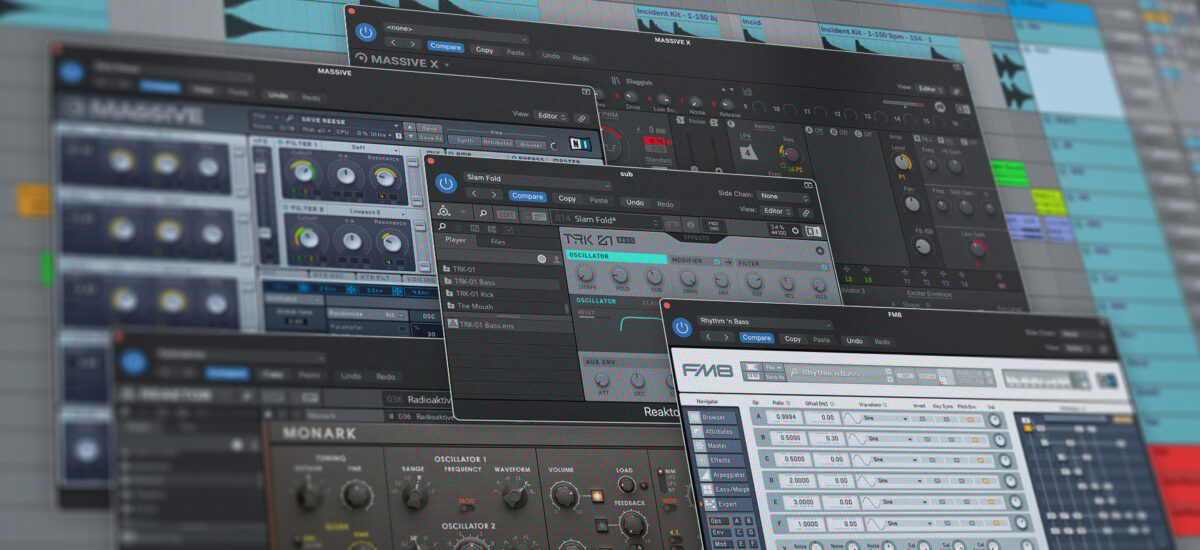When it comes to music production, one of the most versatile tools you can have in your arsenal is a synthesizer. Synthesizers allow you to create a wide range of sounds and textures, making them extremely popular among producers and musicians alike.
If you’re an Ableton Live user, you have access to a variety of synthesizers that come bundled with the software. Each synthesizer has its own unique characteristics and features, which can make choosing the right one a bit overwhelming, especially for beginners.

Credit: samplefocus.com
1. Analog Synthesizers
Analog synthesizers are designed to replicate the sound generation methods of early electronic musical instruments. They use analog circuits and components to create and shape sounds. Ableton Live offers several analog synthesizers, such as Analog and Operator.
Analog: Analog is a powerful subtractive synthesizer that emulates the characteristics of vintage analog hardware. It features two oscillators, a multimode filter, and various modulation options.
Operator: Operator is a frequency modulation (FM) synthesizer that allows you to create complex and evolving sounds. It offers four oscillators and a vast array of modulation possibilities.
2. Wavetable Synthesizers
Wavetable synthesizers are a modern type of synthesizer that use wavetables as their sound source. Wavetables contain a collection of pre-recorded waveforms that can be manipulated in real-time. In Ableton Live, you have two popular wavetable synthesizers: Wavetable and Serum.
Wavetable: Wavetable is a versatile synthesizer that lets you create evolving and complex sounds using its extensive wavetable library. It offers powerful modulation capabilities and an intuitive interface.
Serum: Serum is a third-party wavetable synthesizer that has gained immense popularity among producers. It features a wide range of wavetables and a comprehensive set of modulation options, making it a favorite for sound designers.
3. FM Synthesizers
FM synthesizers use frequency modulation to generate sounds. They are known for their ability to create bright and metallic tones and are widely used in genres like electronic and pop music. Ableton Live includes a notable FM synthesizer called FM8.
FM8: FM8 is a software synthesizer developed by Native Instruments. It offers powerful FM synthesis capabilities, a flexible modulation system, and an extensive library of presets. It is highly regarded for its ability to create rich and complex sounds.

Credit: blog.native-instruments.com
4. Physical Modeling Synthesizers
Physical modeling synthesizers simulate the behavior of acoustic instruments and allow you to create realistic emulations of pianos, strings, and other acoustic sounds. Ableton Live provides a unique physical modeling synthesizer known as Collision.
Collision: Collision uses algorithms to recreate the resonant properties of objects colliding, giving you the ability to generate an array of percussive and tonal sounds. It is perfect for producing realistic percussion and plucked instrument sounds.
5. Sampler and Simpler
Although Sampler and Simpler are not traditional synthesizers, they are powerful tools for sample-based sound design in Ableton Live.
Sampler: Sampler is a professional-grade sampling instrument that lets you manipulate and manipulate samples in numerous ways. It offers advanced mapping and modulation options, making it a favorite among sample-based music producers.
Simpler: Simpler is a streamlined version of Sampler, offering a more straightforward interface for quickly loading and manipulating samples. It is perfect for anyone looking to dive into sample-based production with ease.
By understanding the different types of synthesizers in Ableton Live, you can unlock an infinite world of sound possibilities. Whether you’re a beginner or an experienced producer, each synthesizer offers unique features that can help you craft your sonic landscapes. Experiment with different synthesizers and let your creativity soar!
Frequently Asked Questions For Understanding The Different Types Of Synthesizers In Ableton Live: Master Your Music Creation
What Are The Main Types Of Synthesizers Used In Ableton Live?
The main types of synthesizers used in Ableton Live are analog, digital, and software synthesizers. Each type has its own unique characteristics and sound capabilities.
How Does An Analog Synthesizer Differ From A Digital Synthesizer?
Analog synthesizers generate sound using electronic circuitry and are known for their warm and organic sound. On the other hand, digital synthesizers use digital signal processing to create and manipulate sounds, offering a wide range of sonic possibilities.
What Are The Advantages Of Using Software Synthesizers In Ableton Live?
Software synthesizers in Ableton Live offer a convenient, portable, and versatile solution for music production. They also provide a wide variety of sound options, easy integration with other software, and the ability to save and recall presets.
Can I Use Both Hardware And Software Synthesizers In Ableton Live?
Yes, Ableton Live allows seamless integration of both hardware and software synthesizers, providing users with the flexibility to combine different sonic textures and timbres in their music production.